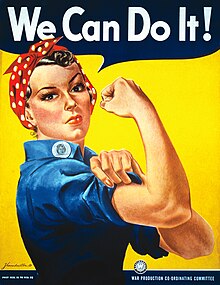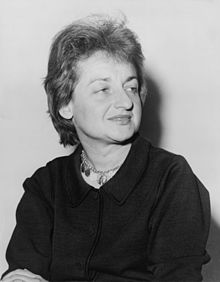Wikipedia:Wikipedia Signpost/2012-03-12/WikiProject report
WikiProject Women's History



This week, we interviewed WikiProject Women's History, which celebrated its first birthday last month. Despite the project's youth, it has assembled a collection of 82 pieces of Featured content, over 100 Good Articles, and two task forces dealing with women in World War I and women and technology. In honor of Women's History Month, the project has started a month-long drive involving collaborations between several WikiProjects, with real-life meetups scheduled in cities around the globe. We interviewed Penny Richards, OttawaAC, SarahStierch, and Ipigott.
What motivated you to join WikiProject Women's History? Have you been involved in any other projects related to history or gender studies?
- Penny Richards: I'm a research scholar with UCLA's Center for the Study of Women, and I've worked on editorial boards for several print encyclopedias, mostly contributing articles about women. This project just seemed like a good opportunity to learn more about how to contribute to Wikipedia.
- OttawaAC: I started editing after reading some newspaper interviews given by Sue Gardner and Jimmy Wales where they mentioned the gender gap among Wikipedia editors, and discussed some research that had shown a relative lack of articles focused on women's issues in general. It occurred to me that a lot of young people who routinely use Wikipedia might jump to the conclusion that if a topic isn't already covered in Wikipedia, that it must not be important at all—that is a scary possibility as far as I'm concerned. I have an undergraduate honours degree in History and had studied approaches to researching people and events that have been largely left out of conventional history books, such as women, blue collar workers, and so on, so reading those interviews piqued my interest whereas I hadn't previously given any thought to writing Wikipedia articles myself.
- SarahStierch: I joined WikiProject Women's History after working on biographies for the National Women's History Project, which I stumbled across through my involvement in WikiProject Feminism. I enjoy writing biographies and many happen to be about women, so it only seemed natural to join!
WikiProject Women's History is home to 79 pieces of Featured material and over 100 Good Articles. Have you contributed to any of these articles? What are some challenges editors face when improving articles about women's history to FA or GA status?
- SarahStierch: I rewrote and expanded Louise Nevelson, and with the help of other users it was awarded GA status. This is one of two GAs I've ever had (the other is about male artist Wadsworth Jarrell). The GA process can be rather tiring, so I don't make it my end all with articles. I appreciate the efforts of those who do, and those who review FAs and GAs, however. I'm a researcher by trade, so perhaps my experience in writing content related to women's subjects is a bit easier than for others. One struggle can be the lack of free resources online, unless you have access to researcher databases like JSTOR. If there is a gender gap on Wikipedia, there is most likely a gender gap in content available online from reliable sources.
The majority of the project's Featured Articles are biographies. Why has the promotion of non-biographical articles lagged behind biographical articles? What can be done to increase the project's Featured Articles about movements, organizations, artwork, culture, and other historical topics?
- OttawaAC: That's a good question, and I wish I had an answer. It may be that editors try to relate to women's history on a personal level, so they gravitate towards biographies. Writing about a movement or an organization often involves more difficult research, since reliable sources on women's history topics can be hard to track down. I'm optimistic that when Wikipedia introduces a less technically challenging editing tool, more editors with a background in history, sociology, cultural studies, and so on, will join in and start writing some interesting material.
The project includes some fictional and mythological characters within its scope. How do these articles relate to the larger goals of WikiProject Women's History? What criteria are used to determine inclusion of an article about a fictional or mythological character into the project?
- Penny Richards: There are certainly precedents for this: The Biographical Dictionary of Scottish Women (Edinburgh University Press, 2006) includes entries on mythological and fictional women, for example. I think of coinage, and statuary, where it's not unusual to find real men but allegorical women depicted. (In US history, think George Washington vs. Columbia; the Lincoln Monument vs. the Statue of Liberty.) Women artists and writers have storied representations of their experiences when it wasn't acceptable to be more direct in their statements; the lines between fiction and memoir become a little blurry. (Again from US history, think of works like The Yellow Wall-Paper or The Awakening). So a women's history project will often include cultural depictions, to capture all that.
- OttawaAC: Female figures that are cultural icons are capable of developing historic significance, whether they are fictitious, figures from folklore, mythology, or even religious figures like goddesses and saints. They become cultural icons by representing what society idealizes or denigrates in women. Rosie the Riveter has been held up as a positive role model for young women and so she is an influential, and therefore historically notable, modern feminist icon.
Since March is Women's History Month, does the project have any special plans? Is WikiProject Women's History collaborating with any other projects to improve articles in March? How can editors who are not currently affiliated with one of these projects get in on the festivities?
- Ipigott: Thanks to alerts from SarahStierch at the beginning of February, many WikiProjects have been informed of the opportunity to collaborate. One of the most active has been WikiProject Architecture, where some 40 new articles on women architects have already been written, many of them directly relevant to women's history.
- SarahStierch: Myself and a group of editors are planning events around the world related to women's history month; you can learn more here. I'm hoping this will be able to blossom into something much larger in the future, related to not only writing about women's history, but mainly a larger editing event that encourages women's participation around the world in Wikimedia projects. The link I just provided for WikiWomen's History Month is a great starting point to find inspiration, or connect with your favorite WikiProject and start something there, like for example, WikiProject Architecture has done.
Anything else you'd like to add?
- OttawaAC: I'm thrilled to see the increase in Women's History articles in recent months. On the other hand, I'd also like to see the women's angle get more coverage in history articles that have a more general focus, too.
Next week, we'll check out another Wikipedia. Until then, Czech out the archive.



Discuss this story